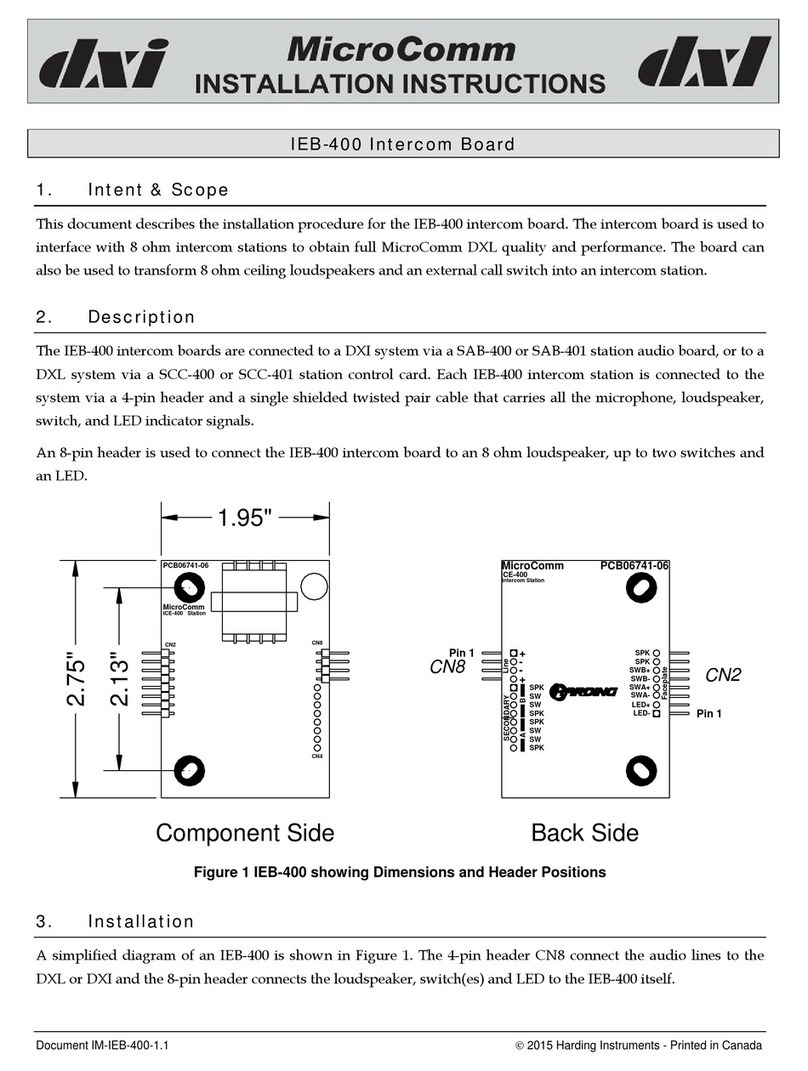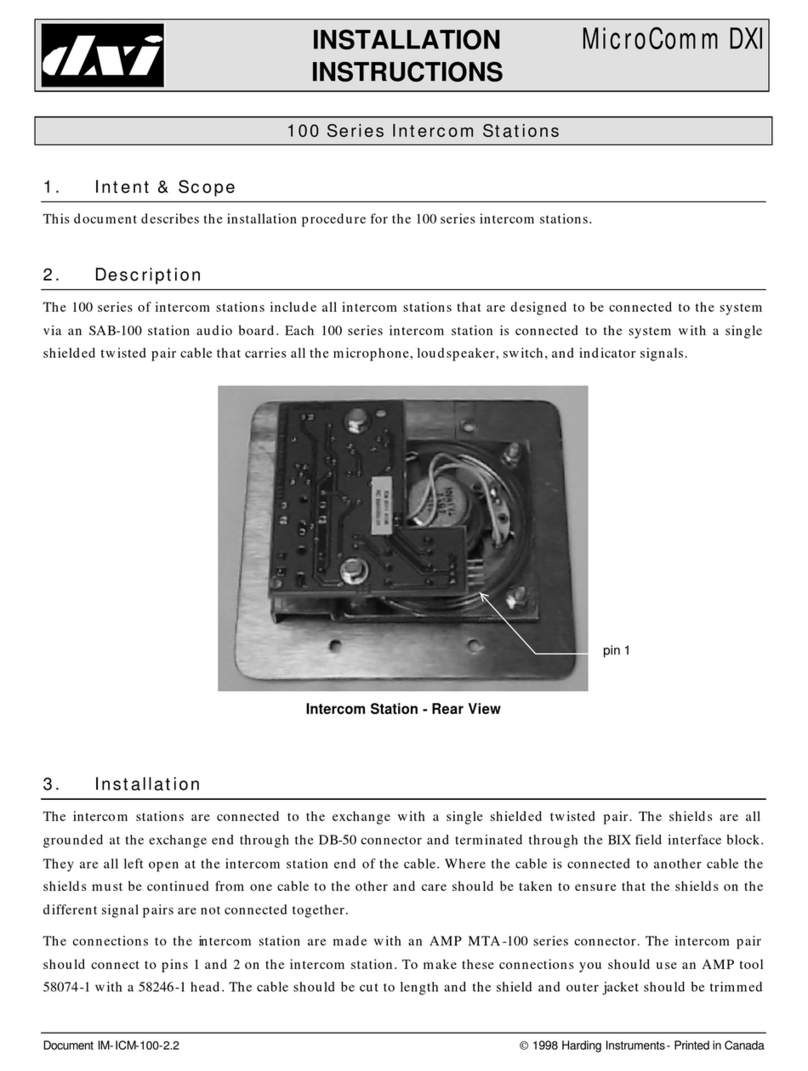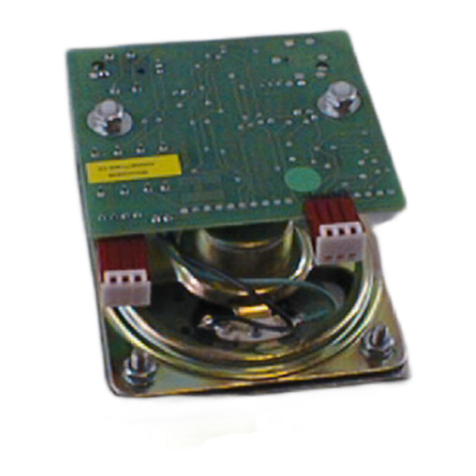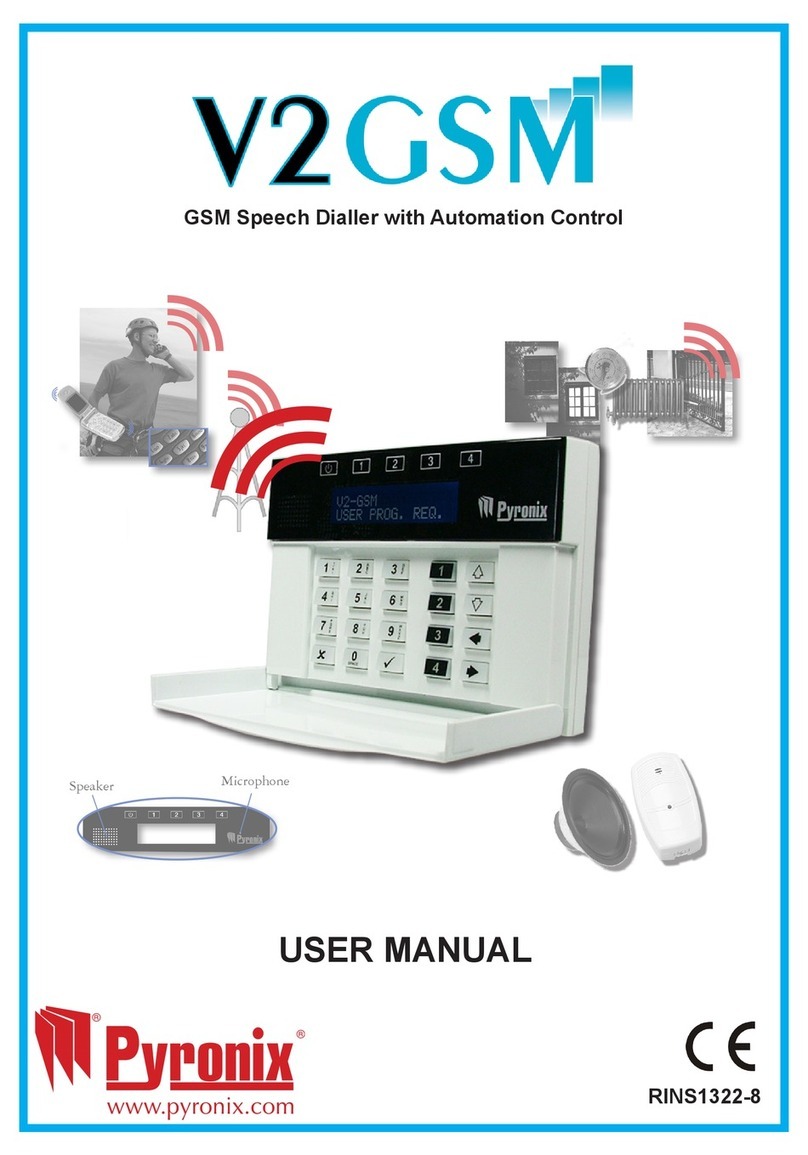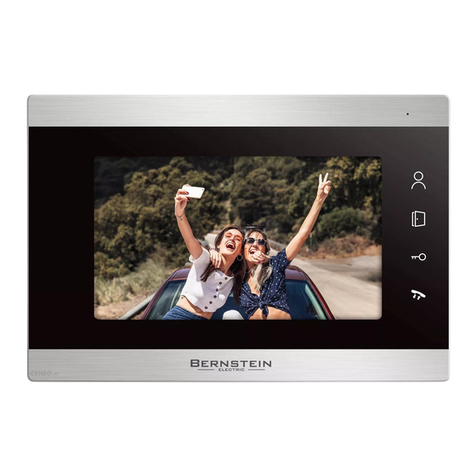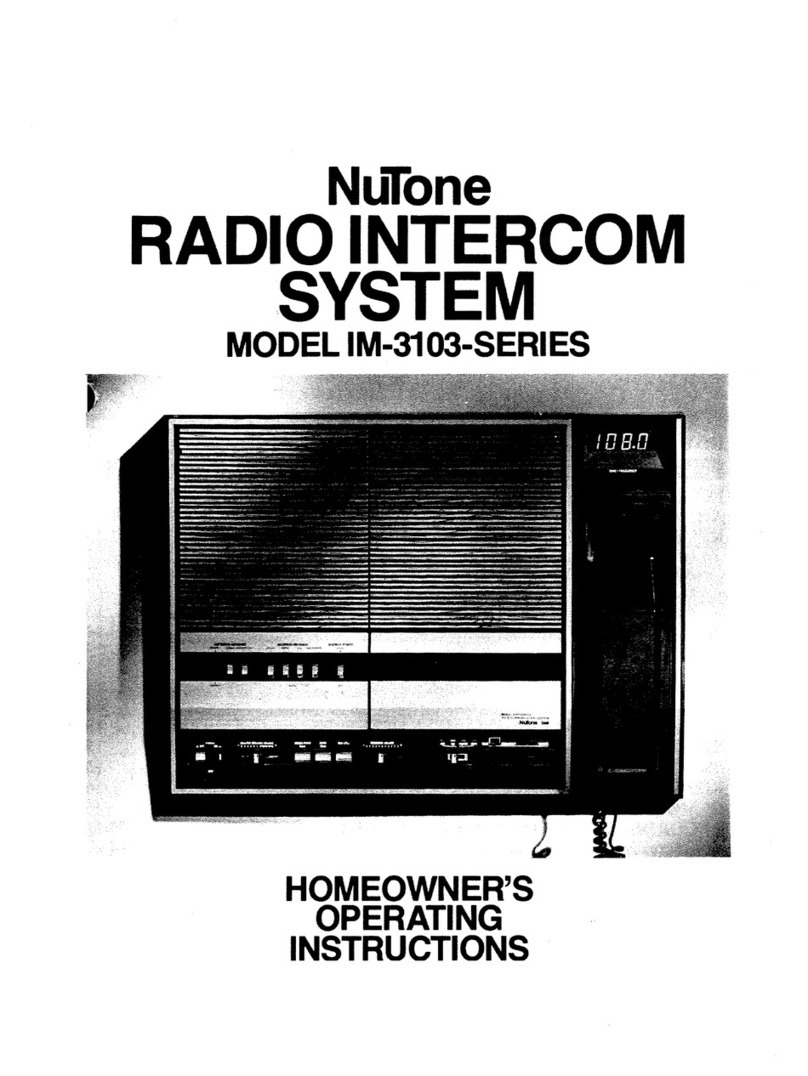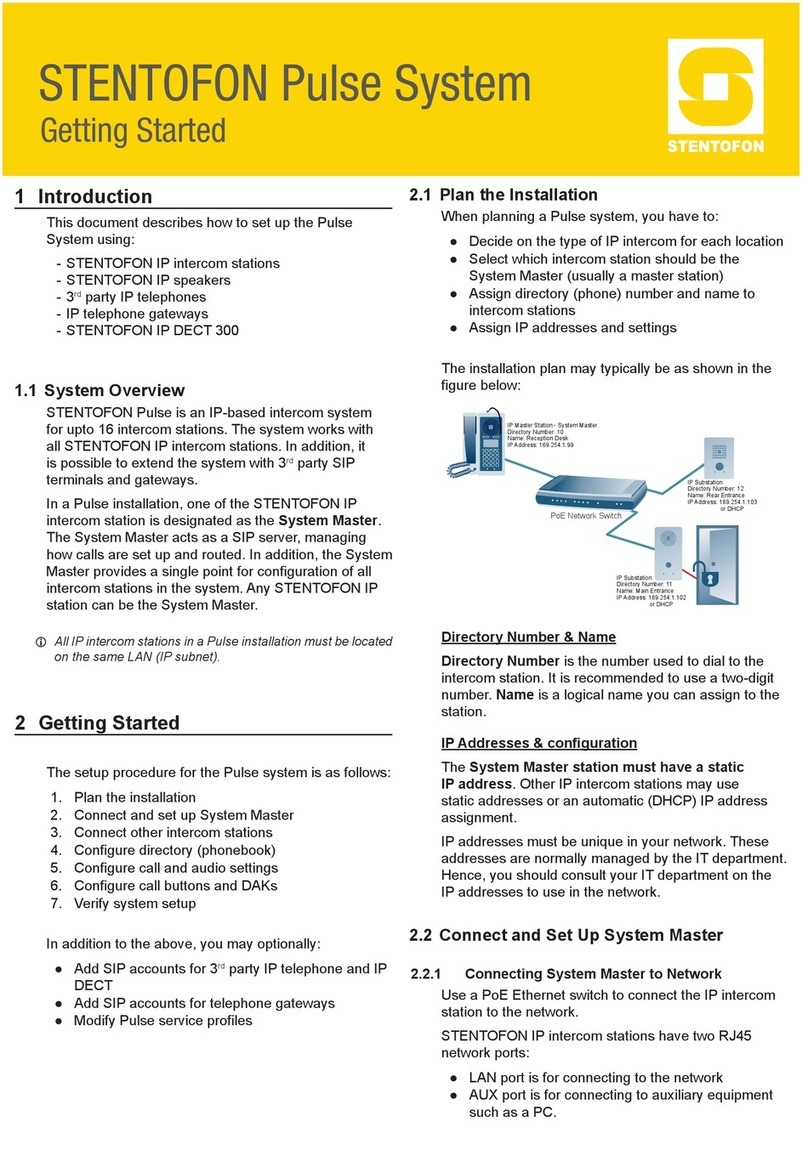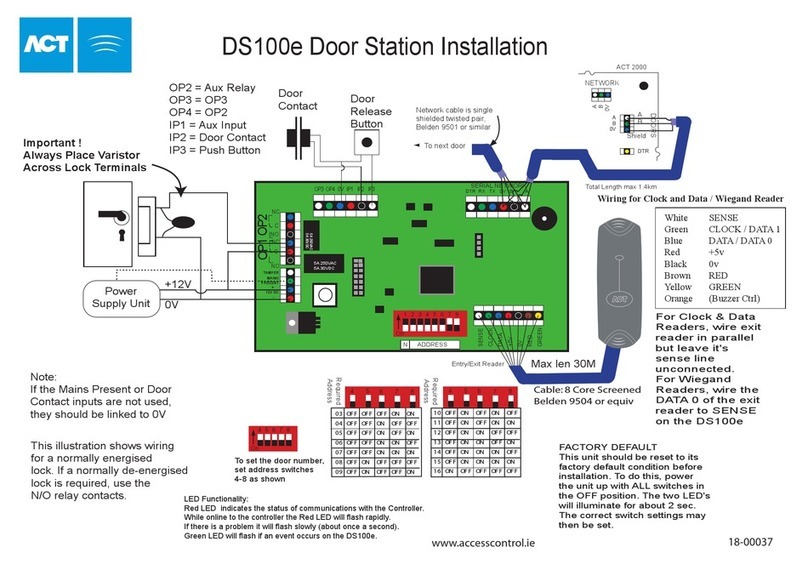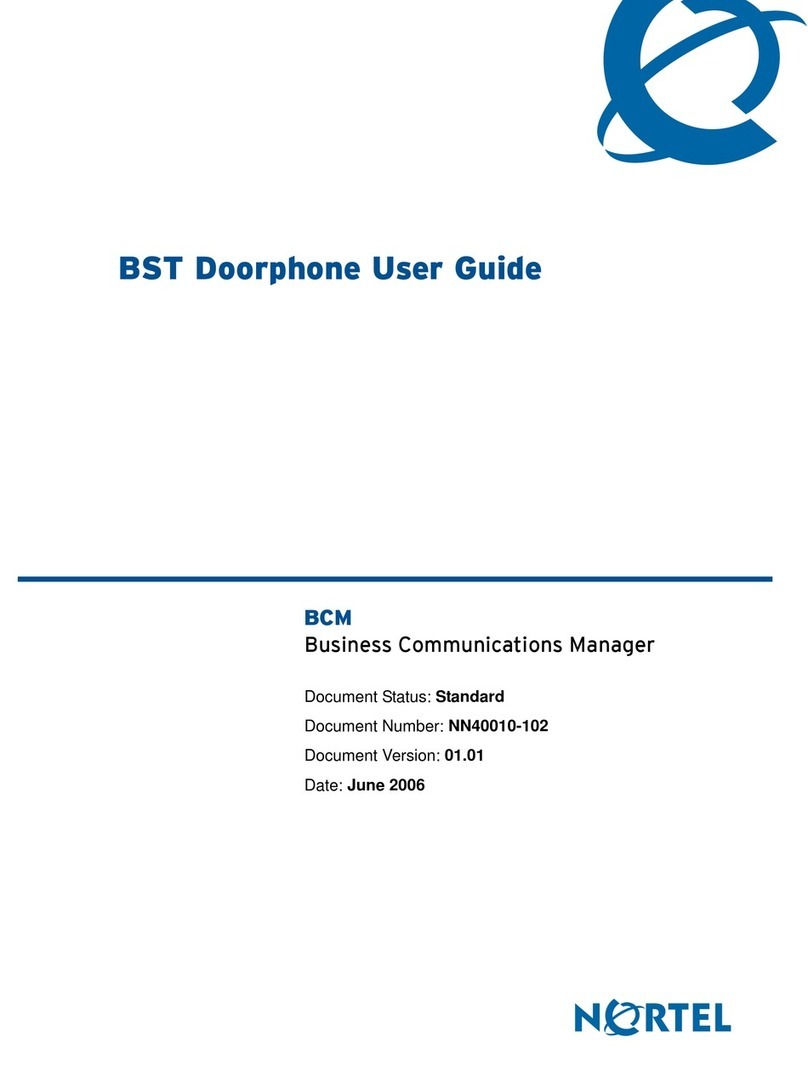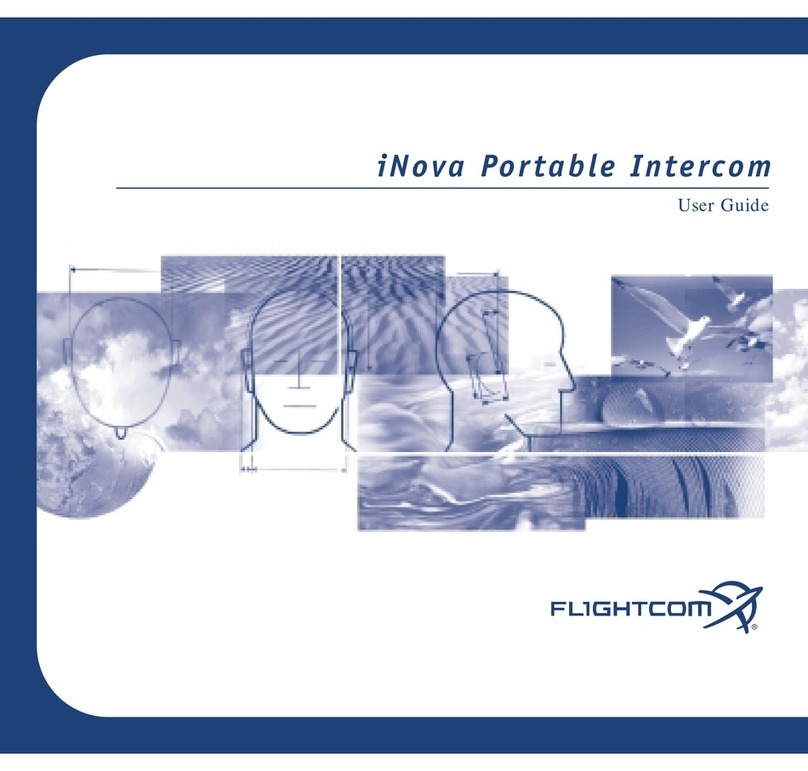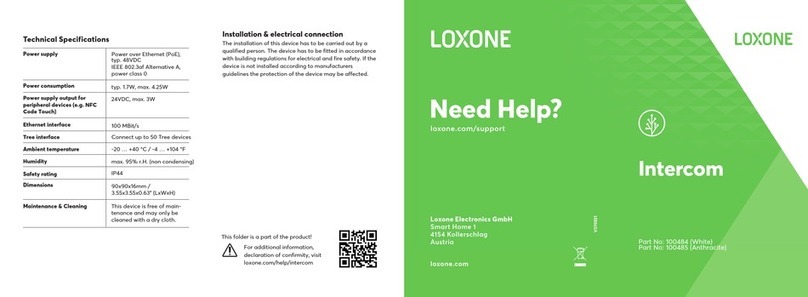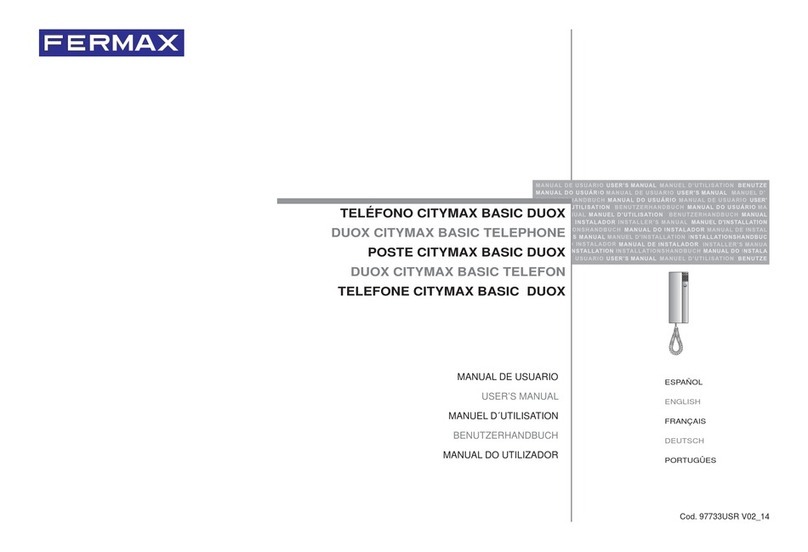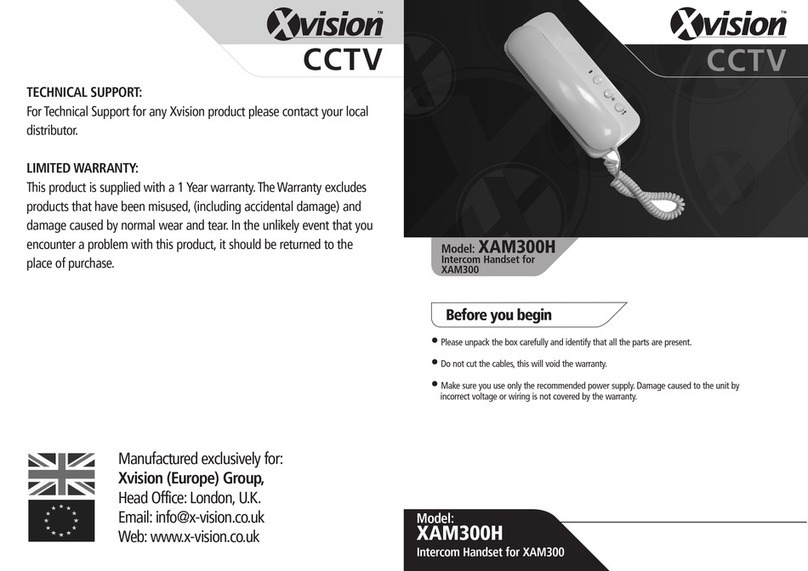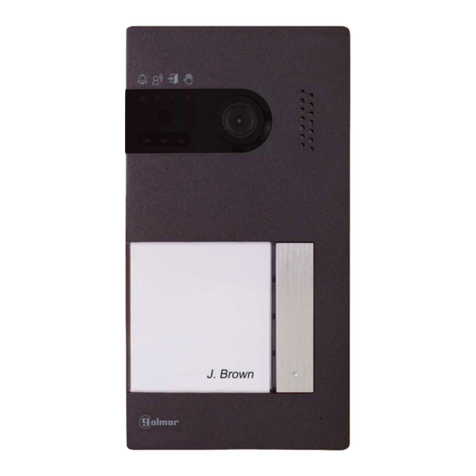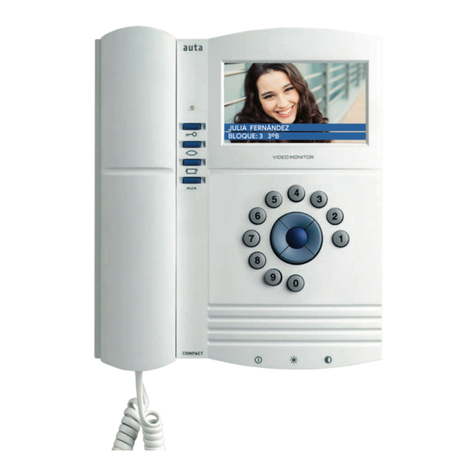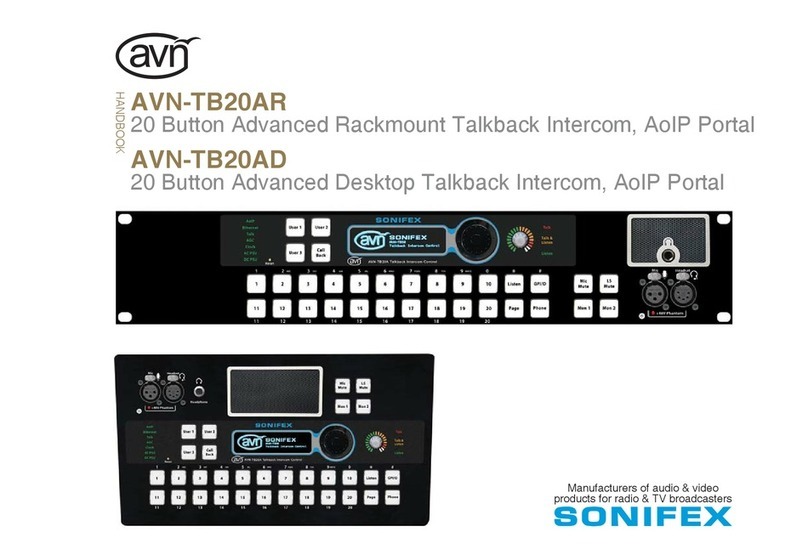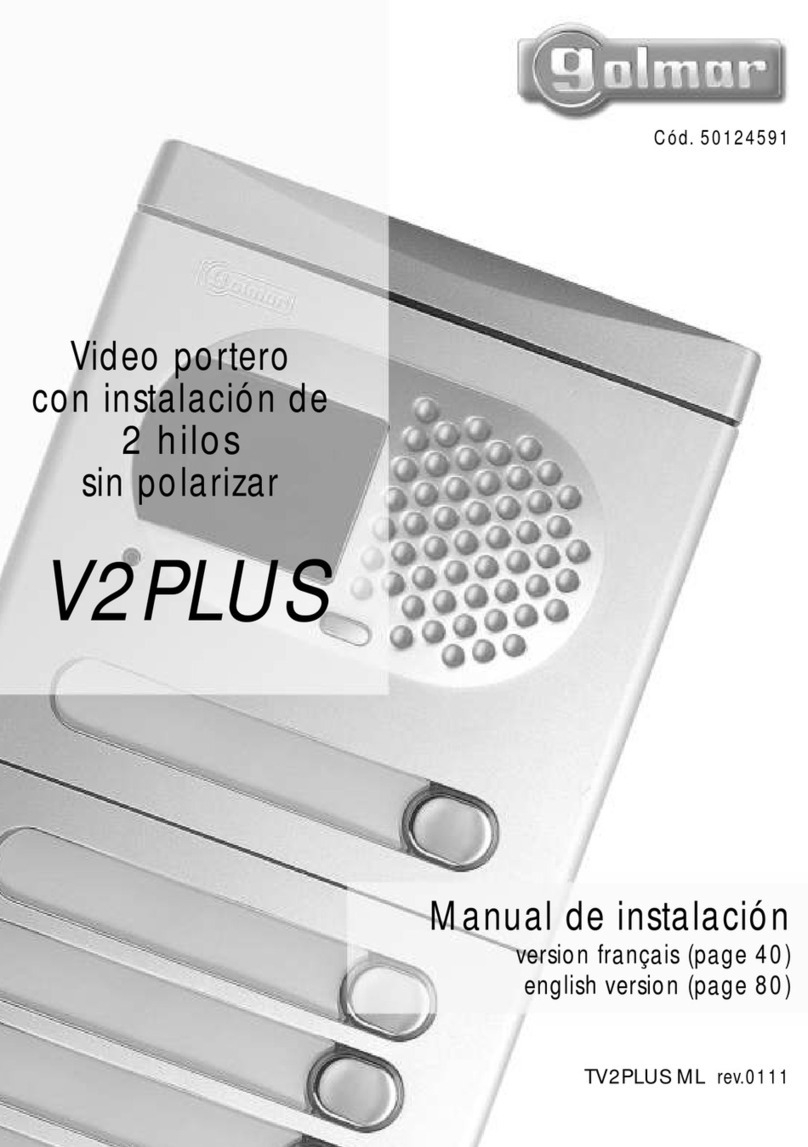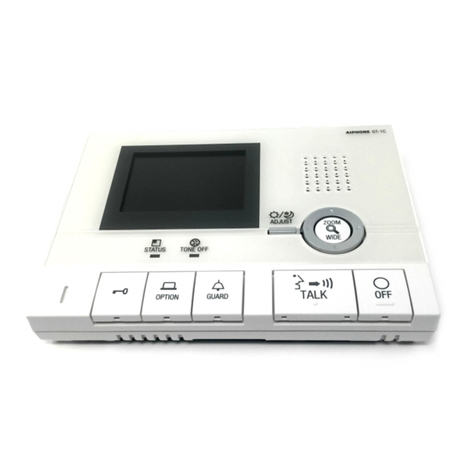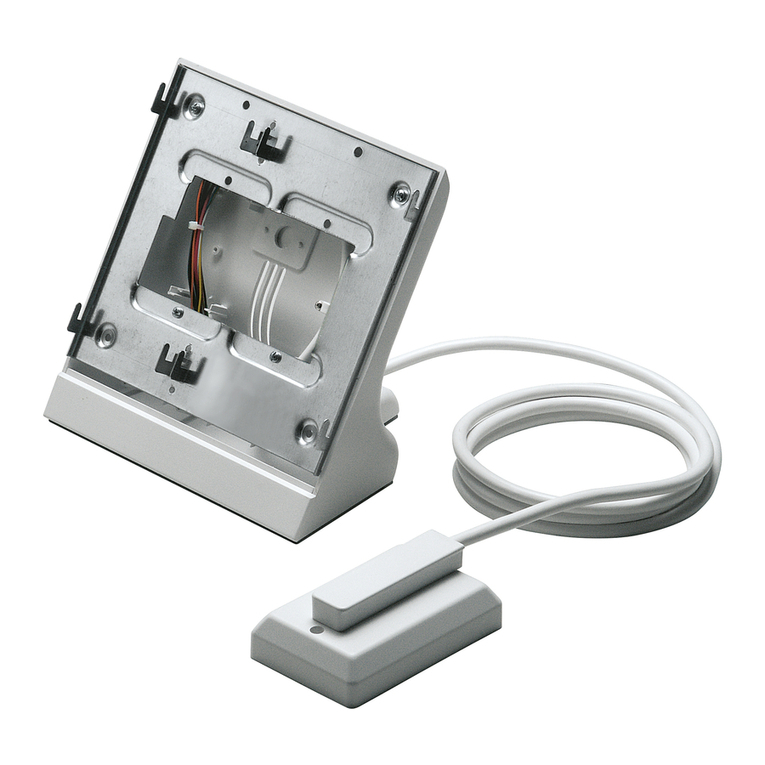Harding Instruments MicroComm DXL User manual

IMS-640/641 VoIP Intercom Master Station Operating Instructions MicroComm DXL
Printed in Canada 2019 Harding Instruments
MicroCommDXL
IMS-640 and IMS-641
VoIP Intercom Master Station
Operating Instructions
March, 2019

MN-DXL-IMS-640/641-1.0. Page 2

IMS-640/641 VoIP Intercom Master Station Operating Instructions MicroComm DXL
Page i MN-DXL-IMS-640/641-1.0
Table of Contents
Section 1 - Introduction ............................................................................................................................1
Purpose of This Manual..........................................................................................................................1
Welcome to the MicroComm DXL ..........................................................................................................1
Elements of the System............................................................................................................................1
The Master Station..................................................................................................................................2
This Operating Manual...........................................................................................................................2
Notation Used in This Manual ................................................................................................................3
Section 2 - Getting Started........................................................................................................................5
What is a DXL Intercom Station? ...........................................................................................................5
How the DXL System Handles Alarms....................................................................................................5
How the DXL Handles Call Requests .....................................................................................................5
Intercom Stations.....................................................................................................................................6
Initiating a Call Request......................................................................................................................6
Disabled Stations.................................................................................................................................6
Intercom Calls .....................................................................................................................................6
Station Identification ........................................................................................................................... 7
Station Priority .................................................................................................................................... 7
IMS-640/641 VoIP Intercom Master Station ..........................................................................................7
Display ................................................................................................................................................ 8
Telephone keys....................................................................................................................................8
Telephone Keypad...............................................................................................................................9
Navigation Keys..............................................................................................................................9
Function Keys .................................................................................................................................9
Hold Key ......................................................................................................................................... 9
Release Key..................................................................................................................................... 9
Audio Keys....................................................................................................................................10
Beeper................................................................................................................................................ 10
Loudspeaker and Microphone...........................................................................................................10
Handset.............................................................................................................................................. 11
Section 3 - Principles of Operation........................................................................................................13
Menu System..........................................................................................................................................13
Function menus .....................................................................................................................................14
Use of the Right-Arrow Key ..................................................................................................................15
List of Functions....................................................................................................................................16

IMS-640/641 VoIP Intercom Master Station Operating Instructions MicroComm DXL
MN-DXL-IMS-640/641-1.0. Page ii
Function.................................................................................................................................................16
Lists ...................................................................................................................................................17
How Lists are Displayed ...................................................................................................................18
Alarm Code .......................................................................................................................................18
ID Number and Name............................................................................................................................19
List Order...........................................................................................................................................19
List Sizes ...........................................................................................................................................19
Section 4 - Intercom Procedures............................................................................................................21
How to Select a List...............................................................................................................................21
How to Select a Station .....................................................................................................................22
Scrolling ............................................................................................................................................22
If you know the ID Number of the Station........................................................................................22
A Shortcut to Help With Long Lists..................................................................................................23
To Back Out of Your Selection .....................................................................................................23
Making a Call to a Station.....................................................................................................................24
Functions Available When You are Making a Call...........................................................................25
Level Setting Adjustments ................................................................................................................25
Call Requests.........................................................................................................................................26
Responding to a Call Request................................................................................................................26
Acknowledging the Call Request ......................................................................................................26
Ending the Call ..................................................................................................................................26
Section 5 – Enabling and Disabling Stations.........................................................................................27
Enabling/Disabling Intercom Stations..................................................................................................27
Enabling/Disabling Call Request Switch at an Intercom Station......................................................27
Enabling Call Request Switch from the Disabled list .......................................................................28
Enabling/Disabling Tamper Alarm at an Intercom Station...............................................................28
Enabling/Disabling Music at an Intercom Station.............................................................................28
Setting the Audio Level Alarm Thresholds for an Intercom Station.................................................28
Section 6- Monitoring Procedures .........................................................................................................31
Monitoring a Station..............................................................................................................................31
Background Monitoring ........................................................................................................................32
Monitoring a Visiting Booth..................................................................................................................33
Section 7 –Alarm Handling Procedures................................................................................................35
Section 8 - Other Master Station Procedures .......................................................................................37
Changing Master Station Display and Sound Volume Settings............................................................37
Changing Clock Display Mode .........................................................................................................37

IMS-640/641 VoIP Intercom Master Station Operating Instructions MicroComn DXL
Page iii MN-DXL-IMS-640/641-1.0
To Change Programming (Music)..................................................................................................... 38
Activating a Signal ................................................................................................................................38


IMS-640/641 VoIP Intercom Master Station Operating Instructions MicroComn DXL
Page 1 MN-DXL-IMS-640/641-1.0
Section 1 - Introduction
Purpose of This Manual
This manual is intended to familiarize you with the operation of the MicroComm DXL IMS-640/641 VoIP
Intercom Master Station. The IMS-640/641 is a telephone style intercom station that uses Voice over Internet
Protocol (VoIP). The IMS-640/641 connects to an exchange via the inter-exchange Network (an Ethernet
network).
The menus are similar to those used by the IMS-440 series of intercom master stations. You should easily master
the operation of the IMS-640/641 if you are already familiar with the operation of the IMS-440.
Welcome to the MicroComm DXL
The MicroComm DXL intercom system is designed to make your job easier. Here are some of the DXL’s main
features:
an Intercom Station can request your attention when needed
you can call an Intercom Station at any time
you can communicate with other Master Stations in your system
if you do not respond to a call request within a specified time, another Master Station will be notified
(assuming there are at least two Master Stations in your facility)
you can make zoned paging announcements directly from your Master Station
you can “step” through Intercom Stations to monitor what is happening at their locations
you can control whether a program is distributed to intercom stations and paging zones
you can adjust the volume of your Master Station and the Intercom Station you are speaking with during
the call
all important activities are logged and saved for printing or reference, and
for ease and speed of maintenance, the system generates alarms whenever wiring faults and other internal
system failures are detected
Elements of the System
The DXL system consists of:
Intercom Stations
Master Stations that can communicate with Intercom Stations and other Master Stations
Secondary Master Stations, at which call requests not answered by a Master Station in a timely manner,
and other alarms are annunciated,
Digital Communications Controller (DCC), contains process control card, master control card and up to
two station control cards,
Digital Communications Expander (DCE) contains process control card (with reduced functionality) a
master control card and up to two station control cards.

IMS-640/641 VoIP Intercom Master Station Operating Instructions MicroComm DXL
MN-DXL-IMS-640/641-1.0. Page 2
other system devices such as paging speakers, page zone expanders (PZE), talk back expanders (TBE),
program sources, telephone type stations, etc.
All of these elements are linked together in a communications network.
The Master Station
You can use your IMS-640/641 Master Station to perform a wide range of intercom and alarm functions. From
your Master Station you can:
call an Intercom Station
call another Master Station
respond to an intercom call request
disable an Intercom Station or alarm monitor point
(re)enable an Intercom Station or alarm monitor point
monitor the intercom status of every Intercom Station that is connected to your Master Station
make public address announcements to Intercom Station and loudspeaker zones
turn program distribution to Intercom Stations and zones on or off
This Operating Manual
This operating manual is designed to help you learn to use all of the important features of your Intercom Master
Station. It will also serve as a handy reference document.
The manual is divided into eight sections, each one dealing with a key aspect:
Section 1 Introduction
Section 2 Getting Started
Section 3 Principles of Operation
Section 4 Intercom Procedures
Section 5 Enabling and Disabling Stations
Section 6 Monitoring Procedures
Section 7 Alarm Handling Procedures
Section 8 Other Master Station Procedures
Remember that the DXL is an intercom system designed to help you do your job more effectively.
The more familiar you are with its operation, the easier your job will be!

IMS-640/641 VoIP Intercom Master Station Operating Instructions MicroComn DXL
Page 3 MN-DXL-IMS-640/641-1.0
Selected text is represented by
inverted text
Notation Used in This Manual
Your Intercom Master Station uses text on a dark background of the LCD
display to represent such things as a selected Intercom Station or which
list you are viewing. In this manual, the selected text is shown as inverted
text.
2001 Housing1Exit 0
Reject
Master Station #20
Accept
Station :131
2003 UnitAEntry
0
2001 Housing1Entry
0


IMS-640/641 VoIP Intercom Master Station Operating Instructions MicroComn DXL
Page 5 MN-DXL-IMS-640/641-1.0
Section 2 - Getting Started
What is a DXL Intercom Station?
In a MicroComm DXL system, an Intercom Station refers to a speaker/microphone combination from which
audio communications can be carried out. Associated with the Intercom Station are one or more switches that can
be used to generate call request, select programs or other possible functions.
How the DXL System Handles Alarms
The MicroComm DXL is an integrated system that handles a wide
variety of alarms, in addition to intercom call requests. To simplify
operation of the system, the DXL treats call requests and alarms in the
same basic fashion. (The only difference between the two is that, with
call requests, intercom functions are available.)
First we will discuss how the DXL handles alarms.
Normally, the Stations that communicate with your Master Station are
in the “idle” state.
When a Station initiates an alarm, the alarm is sounded at your Master
Station, and the system changes the state of that Intercom Station
from “idle” to “alarm”.
When an alarm is acknowledged, the system changes the status of the Station from “alarm” to “acknowledged”.
And when the alarm is canceled, the system changes the status of the Station from “acknowledged” back to “idle”.
The DXL keeps track of the status of all Stations and displays this information for you - as lists of Stations with
“alarm” and “acknowledged” status.
Now let’s look at call requests.
How the DXL Handles Call Requests
When a call request is initiated at an Intercom Station, the Master
Station alerts you (with a beep). The station that initiated the call
request is added to the Event Queue. Until the call request is
acknowledged, the Master Station will sound an alarm reminder beep
at a regular interval.
When you acknowledge the call request:
a tone sounds at the Intercom Station to let the calling party
know that the call request has been acknowledged,
the DXL removes the Intercom Station from the Event Queue,
and
your Master Station is connected to the Intercom Station.
Once you are connected, you may speak to the calling party, or listen.
When you have completed your communications with the Intercom Station you may “end” the call.
Acknowledge
Alarm
Station Status
is "Idle"
Station Status
is "Alarm"
Station Status
is "Acknowledged"
Receive
Alarm
Cancel
Alarm
Acknowledge
Call Request
Station Status
is "Idle"
Station Status
is "Alarm"
Station Status
is "Acknowledged/Call"
Receive
Call Request
End
Call

IMS-640/641 VoIP Intercom Master Station Operating Instructions MicroComm DXL
MN-DXL-IMS-640/641-1.0. Page 6
After a fixed interval, if the call request is not acknowledged (or canceled), it will “time out” and a call request
time-out alarm will be annunciated at the Secondary Master Station. (The original call request remains queued at
the Master Station.)
Note: When the system is set up, the System Administrator will set the time allowed before a time-out
alarm is triggered by a failure to respond to the call request.
A Secondary Master Station is simply another Master Station designated to receive time out calls, fault reports as
a back up function.
All intercom activities (call requests, calls, cancels, etc.) are logged so that they can be printed and accessed for
review.
Intercom Stations
A typical Intercom Station consists of:
a call switch
a loudspeaker/microphone, which enables two-way
communication.
Intercom Stations may also take the form of telephone handsets, talkback
loudspeakers with call request buttons, etc. Whatever their configuration,
they include a means to place a call request and a means of two-way
communication. They may include call indicator lights to signal that call
requests have been placed or that calls have been acknowledged.
Initiating a Call Request
A call request is initiated by pressing the call request switch (lifting the telephone handset, etc.) at the Intercom
Station.
A call request will not be able to be initiated from an Intercom Station if:
the Station is disabled, or
the Station has initiated a call request that has not yet been acknowledged.
Disabled Stations
If you disable an intercom or other station, it can no longer initiate a call request. However, you may call a
disabled Intercom Station.
At any time, you may enable a disabled Station, which puts it back into operation.
When you disable a Station, it is added to the Disabled List. When you enable a disabled Station, it is removed
from the Disabled List.
Intercom Calls
Your Master Station will be connected to the Intercom Station whenever:
Typical Intercom Station

IMS-640/641 VoIP Intercom Master Station Operating Instructions MicroComn DXL
Page 7 MN-DXL-IMS-640/641-1.0
you initiate a call to the Intercom Station, or
you acknowledge a call request. (In this case, the Master Station is automatically connected to the
Intercom Station.)
When you call an Intercom Station, a call announce tone sounds (this indicates to the party at the Intercom
Station that you are calling, or that you have acknowledged the call request).
Note: An Intercom Station cannot initiate a conversation with the Master Station. The Intercom Station
can only communicate with the Master Station when the Master Station calls the Intercom Station, or
acknowledges a call request from an Intercom Station.
Station Identification
When the system is initially set up the using the Administrator Software stations will be identified by an ID
number and name. The IMS-640/641 LCD screen will display both.
Station Priority
Each Station is assigned a call request priority in the Administrator Software. Call request priority determines the
order in which Stations that have initiated call requests are displayed on the Event Queue.
A new call request with a high priority will appear on the Event Queue ahead of previously received call requests
with lower priority.
IMS-640/641 VoIP Intercom Master
Station
The IMS-640/641 Intercom Master Station is a
telephone style master station and includes:
a display,
a keyboard,
a beeper
a loudspeaker and microphone, and
a handset
IMS 640/641 Intercom Master Station

IMS-640/641 VoIP Intercom Master Station Operating Instructions MicroComm DXL
MN-DXL-IMS-640/641-1.0. Page 8
8
0
pqrs
*
7
tuv
#
wxyz
9
5
2
ghi
1
4
jkl
abc
3
mno
6
def
Master Station #20
01:51 PM
Jul 8, 2008
Answer Next
Master Setup
0
0
0
Call
Unman
LCD Screen Function Keys
Navigation
Keys
Release
Key
Hold
Key
Message/Ringing
Indicator
Telephone
Keypad
Handset
Audio Keys
14 Programmable
"feature" keys
IMS-640/641 showing keyboard and display
Display
The display is a 128 x 64 pixel LCD screen with backlighting that provides information you need to perform
intercom functions.
Telephone keys
The telephone keys consist of:
a standard telephone-12 key numeric keypad,
four navigation keys,
four function keys
a Hold key (The operation of this key is disabled when the IMS-640/641 functions as a DXL master
station)
a Release key
four audio keys.
14 programmable “feature” keys, each with an LCD indicator

IMS-640/641 VoIP Intercom Master Station Operating Instructions MicroComn DXL
Page 9 MN-DXL-IMS-640/641-1.0
Telephone Keypad
The keypad consists of a numeric key set - (0 to 9), (*) and (#) - in a standard telephone layout. These keys are
used to speed up station selection when performing intercom functions and to set level controls.
Navigation Keys
There are four control keys:
The Up-Arrow key and Down-Arrow key are used to scroll through the displayed list of
stations and to adjust settings and volumes.
The Right Arrow key is used to scroll to a new menu
The Left Arrow key is used to scroll back to a previous menu
Function Keys
Function keys are used to perform the
intercom functions that appear beside them
on the display. Each key is associated with
the function name that appears directly
beside it.
If a function name does not appear beside a
function key, the key is not operative. (If you
press it nothing happen).
The functions that you may perform at any
one time will change, according to the keys
you have pressed, the list displayed and the
station selected.
The center arrow head ►indicates additional functions are available and will be displayed if you press the Right-
Arrow key . Additional functions are available only if a right-arrow head appears in the center of the bottom
two lines of the display.
Hold Key
The HOLD key ( ) is not used in the operation of the IMS-640/641 and its operation is disabled
Release Key
The RELEASE key ( ) is used to abort a value entry and return to previous settings. (The RELEASE key
operation is similar to the CLEAR key operation in an IMS-440.)
Jul 8, 2008
Master Setup
Answer Next
Master Station #20
Unman
Call
0
01:51 PM 0
0
Additional functions
are available
Function
Keys
Function
Keys
Four Function Keys

IMS-640/641 VoIP Intercom Master Station Operating Instructions MicroComm DXL
MN-DXL-IMS-640/641-1.0. Page 10
Audio Keys
The MUTE key is used to temporarily suspend audio communication during a call. It will mute the
Master Station microphone and allow the operator to listen to the connected station. A green LED
indicates when the microphone is muted.
Two volume control keys are used to either increase or decrease the volume of the incoming speech.
The HANDS FREE key is used to allow hands free operation. A green LED comes on when the master
station is in hands free operation.
Audio Switches on the IMS-640/641
Beeper
The Master Station contains a beeper. Various conditions will cause a beep:
new alarm beep
a single tone will sound when a new call request or other alarm is received
an error beep
a single tone will sound when you press a numerical key
reminder beep
a double beep will sound at a fixed interval (from 5 to 60 seconds) as long as all call requests have not
been acknowledged.
The reminder beep interval is set in the Administrator Software.
Note: If you are in a call, the reminder beep and new alarm beep will be disabled for the duration of your call.
Once your call is completed the reminder beep and new alarm beep will automatically be re-activated.
Loudspeaker and Microphone
A loudspeaker and microphone are included in the IMS-640. They are used for hands-free communication with
Intercom Stations and other Master Stations. When using the loudspeaker and microphone to communicate, the
communication is one way at any one time so each party must take turns speaking. The Master Station operates
with a Voice operated switch (VOX) and the communication path will switch automatically so that it routes the
signal from the person speaking to the person listening. The IMS-641 does not use a VOX and the operator must
press the “Hands Free Operation” key to create an audio path from the Master Station to the Intercom Station.
9
78
*
pqrs
#
0
tuv wxyz
Microphone
Mute Increase
Volume Decrease
Volume Hands Free
Operation

IMS-640/641 VoIP Intercom Master Station Operating Instructions MicroComn DXL
Page 11 MN-DXL-IMS-640/641-1.0
Handset
The handset can also be used to communicate with Intercom Stations or other Master Stations. When the handset
is lifted from its cradle, the loudspeaker and microphone are automatically disconnected.
Handset communications to Intercom Stations are one way as for loudspeaker and microphone communications.
When speaking to another Master Station using its handset, both parties can speak and listen at the same time as
for normal telephone communications.


IMS-640/641 VoIP Intercom Master Station Operating Instructions MicroComn DXL
Page 13 MN-DXL-IMS-640/641-1.0
If you press this key the ‘Station’ list
will be displayed
Section 3 - Principles of Operation
Menu System
A compact Master Station requires a small display and a limited sized keyboard. To achieve this goal and still
provide the required functionality, the DXL IMS-640/641 uses four programmable keys (called function keys)
and a menu system that defines the function of the keys. The bottom two line of the display shows the different
functions. Each time you press a function key either the specified action will be carried out or the menu will
change allowing you to make further choices. The structure of menu system resembles an inverted tree, staring at
the top level the menu is called the “Idle menu”.
From the “Idle menu” if we press one of the function keys, for example
Call, we move down the tree to a lower level menu (similar to moving to
one of the tree branches).
In this case the menu will change and the function keys will indicate the
various lists that can be called. These include a list of Master Stations
(Master), a list of Intercom Stations (Station), a list of Page Zones (Zone),
and a convenient entry (Last) that allows you to call the last station you
called. Pressing the navigation key will bring up a new set of lists that
can be called.
Pressing a function key from this menu, for example “Station” will again
change the display and present the list of Stations that you may call. In
place of the menu functions the display will now indicate that you are on
the “Station” list, as well as indicate the total number of Stations on the
list.
If you press this key the ‘Call’
function is performed.
Jul 8, 2008
Master Setup
Answer Next
Master Station #20
Unman
Call
0
01:51 PM 0
0
Jul 8, 2008
Zone
Master
Master Station #20
Last
Station
0
01:51 PM 0
0

IMS-640/641 VoIP Intercom Master Station Operating Instructions MicroComm DXL
MN-DXL-IMS-640/641-1.0. Page 14
The list of Stations that you
can call.
With the limited display area, three station names can be displayed at one
time; however you can use the scroll keys and to move through the
list of stations until you reach the particular station you want to call.
Pressing the Accept function key will connect you to that station.
The menu system will now change and one of the End Call function key
will allow you to terminate the call.
Function menus
The functions have been grouped together for your
convenience into menus. A menu consists of all the
functions you can perform at a point in time. The
following diagram gives a pictorial representation of
the menus that can be reached from the top level
“Idle menu” The “Idle menu” is normally displayed
when there is no system activity. (By repeatedly
pressing the “RELEASE” key you can always return
to the “Idle menu”. Often a menu will consist of two
pages; if a second page is available the right arrow in
the center of the bottom two lines of the display will
be present. Pressing the right arrow navigation key
will display the second page of the menu.
Mapping of Function keys to Representation in
Document
Screen Display during a call
2001 Housing1Exit 0
Reject
Master Station #20
Accept
Station :131
2003 UnitAEntry
0
2001 Housing1Entry
0
Station #2001
My Volume
Master Station #20
Their Volume
End Call
Housing1Entry
Connected to: 0
0
0
Jul 8, 2008
Master Setup
Answer Next
Master Station #20
Unman
Call
0
01:51 PM 0
0
Master Setup
Answer Next Call
Unman
This manual suits for next models
2
Table of contents
Other Harding Instruments Intercom System manuals
